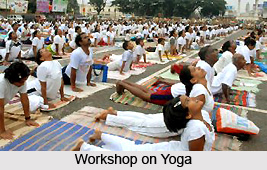 The forty-first yoga sutra speaks about the absolute concentration on samana vayu, by which a yogi attains total control on the element of fire. The central portion of the torso is the location of samana, which controls various vital functions of organs.
The forty-first yoga sutra speaks about the absolute concentration on samana vayu, by which a yogi attains total control on the element of fire. The central portion of the torso is the location of samana, which controls various vital functions of organs.
Samana one of the five prana vayus
Jayat conquest, mastery
Jvalanam shining, burning, blazing, fire
By samyama on samana vayu, a yogi glows like fire and his aura radiates.
By the conquest of samana vayu, the yogi gains control over the element of fire (tejastatwd).
The middle of the torso is the region of samana, which stokes the gastric fire, assisting in digestion and maintaining harmonious functioning of the abdominal organs. It controls the working of the heart, and through it, the life force.
Kapila, founder of samkhya philosophy, seems to have had the power of emitting fire from his eyes, which burnt the sons of King Sagara. The Maharaspian saint Jnanesvar, who wrote a translation and commentary on the Bhagavad Gita, also possessed this power. Nearer to the present time, it is assumed that a pupil of Sri Ramakrishna used to light the path for his master on a dark night.




















